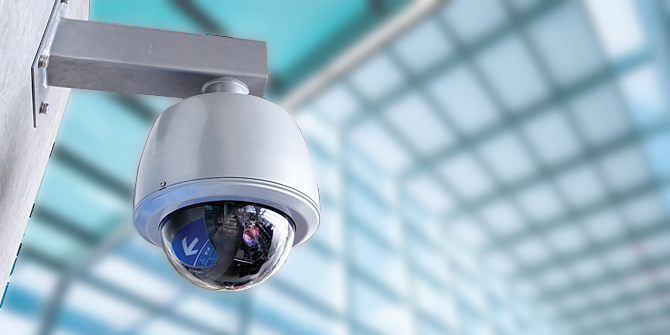Video surveillance is big business. A March 2017 report published by MarketsandMarkets, an international market research firm that serves 1,700 Fortune organizations worldwide, values the video surveillance market at $30.4 billion last year and projects that number to reach $75.6 billion by 2022.
Whether you use your video surveillance system to protect your assets, monitor employee behavior, deter tampering and theft, or lower your insurance rates, you want to be sure it’s reliable. Video surveillance systems can be vulnerable to power problems, such as blackouts, brownouts, surges, and line noise, that can disrupt security cameras and corrupt data. Here are seven solutions to help your system remain functioning at its full potential 24/7.

Security Camera, CCTV on location, airport
1. DVR Lockbox
It isn’t enough to record video footage. You have to ensure its safekeeping. A security DVR lockbox enclosure stores your DVR inside a heavy-duty steel box to keep its valuable data safe and secure. It’s recommended for retail outlets, warehouses, offices and other locations that use a DVR for security purposes.
2. Power Distribution Unit (PDU)
A PDU is necessary to distribute power to servers and network equipment, such as security cameras and a DVR to record video. A switched PDU allows you to control each outlet individually, including remote shutdowns and reboots.
3. Uninterruptible Power Supply (UPS)
Once all your equipment is powered up, you need to ensure it remains powered up to keep your video surveillance system operational all the time. A UPS provides reliable battery backup to keep your system up and running in case of a power failure. Not only will a UPS prevent your system from shutting down when the power goes out, it also protects your data from being corrupted or destroyed.
4. Ethernet Network Switch
All devices in your video surveillance system are connected to your Ethernet network through a switch. Some network switches incorporate a network-grade PDU, which saves you both money and space (two essential devices in one).
5. Cat5e/Cat6/Cat6a Cabling
You’ll need reliable cables to connect your video surveillance equipment to the Ethernet network. Cat5e/Cat6/Cat6a cables transmit high-speed data over long distances. Cabling solutions include copper and fiber patch cables of various lengths and colors. The wide variety of cables ensures you’ll find what you need to fit your application.
6. KVM Switch
A KVM switch provides convenient systems management of connected devices. Select KVM switches offer IP remote access, allowing you to securely access your video surveillance application from any location at any time using a single keyboard, mouse and monitor console.
7. Wall-Mount Rack Cabinet
By adding a PDU, a UPS, a switch and other devices to your video surveillance system, you’ll also need a secure place to store them. Wall-mount rack enclosures are designed to protect your equipment with security features, such as locking doors, shatter-resistant acrylic windows and heavy-duty steel construction.





